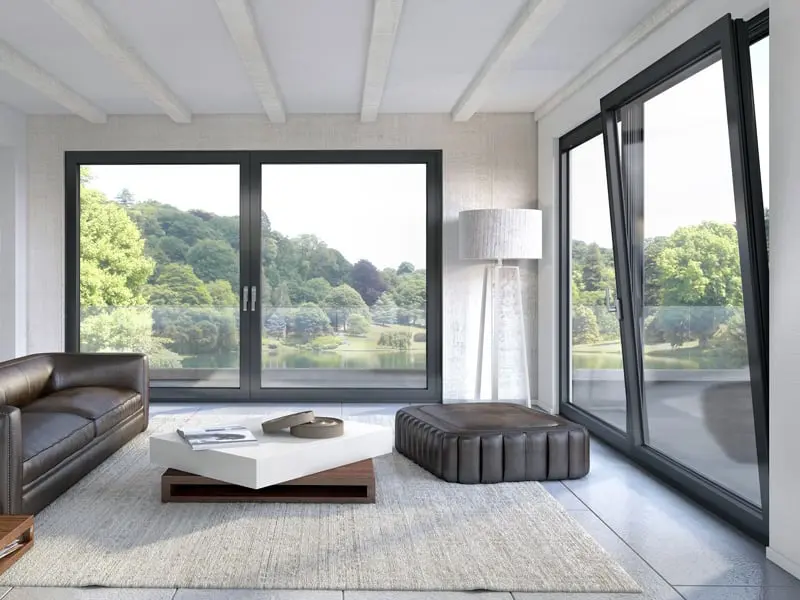
Aluminum vs PVC joinery - advantages and disadvantages

Aluminum joinery has certain advantages and disadvantages compared to PVC joinery, and vice versa. The choice of solution depends on several factors such as the purpose of the building, requirements for cost-effectiveness, durability, and energy efficiency.
A common advantage of aluminum and PVC joinery compared to wooden joinery is durability, good insulation properties, and resistance to external influences. Additionally, they do not require special maintenance, which also brings significant cost savings.
However, aluminum and PVC joinery show certain differences that can influence the purchase decision. Below, read about the advantages and disadvantages of aluminum joinery compared to PVC joinery and make the best decision for your residential or commercial space.
When it comes to insulation, PVC joinery is at the forefront. PVC is an excellent sound and thermal insulator. PVC windows and doors have a low level of thermal conductivity. They retain thermal energy inside the building on cold days and help keep the space conditioned on warm days, resulting in energy savings and cost reduction.
On the other hand, PVC is a flexible material, so the question of its strength may arise. This drawback is addressed by steel reinforcements (profiles) that provide stability and security.
PVC profiles vary in the number of chambers and sealing gaskets, installation depth, and profile section thickness. The most common PVC profiles have five or six chambers. Profiles with a higher number of chambers achieve better insulation properties. Standard quality PVC windows have five chambers and a minimum installation depth of 70mm.
Another advantage of PVC joinery over aluminum joinery is the lower cost. However, it should be noted that the quality and price of PVC joinery are influenced by the quality of the sealing gaskets, hardware, and glass. The quality of sealing gaskets directly affects energy savings and sound insulation. Sealing gaskets also provide protection against dust, water, and wind. PVC windows are usually made with two sealing gaskets, but there are systems with three sealing gaskets.
When it comes to disadvantages, we can say that PVC joinery has a slightly narrower range of colors and decor options compared to aluminum joinery. Another downside is that PVC degrades slowly in nature and is more challenging to recycle, which represents a significant ecological drawback.
Ultimately, the greatest disadvantage of PVC joinery may be the strength and resistance of PVC in large openings. Therefore, for larger openings, it is best to choose aluminum joinery.
Aluminum joinery is more durable and resistant to atmospheric conditions compared to PVC. The lifespan of ALU joinery is significantly longer compared to PVC joinery.
In addition to its long lifespan, aluminum joinery offers a wider range of colors and decor options. Aluminum is lightweight but stable and strong material, making it more suitable for larger openings. Moreover, it is more environmentally friendly and can be recycled an unlimited number of times.
The most pronounced disadvantage of aluminum joinery compared to PVC is its weaker insulation properties due to aluminum being a good thermal conductor. Therefore, energy losses can be significant through window openings and doors.
This insulation problem is solved with the help of a thermal break. Hence, we distinguish between warm and cold ALU profiles. Warm ALU profiles are those with a thermal break and should be used for windows and exterior doors.
ALU profiles with a thermal break contain thermal insulation material - polyamide between the inner and outer sides of the profile. We distinguish aluminum profile with a thermal break aluminum-aluminum, aluminum-wood, and aluminum-PVC.
Cold profiles are ALU profiles without a thermal break and do not have good insulation properties. They are mainly used for internal joinery or rooms where there is not a significant difference in temperature, such as offices, basements, hallways, and garages.
When it comes to price, aluminum joinery is significantly more expensive than PVC joinery. However, it should be noted that the difference in price is influenced by the performance of the joinery itself, such as the number of chambers in PVC, glass quality, warm or cold thermal break, and thermal modules in aluminum joinery.